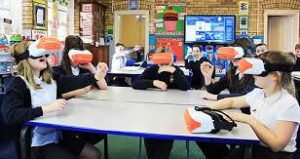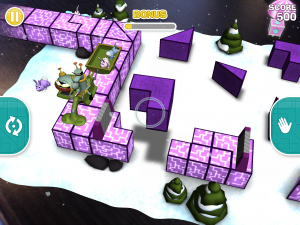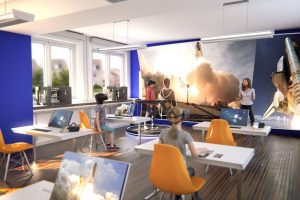Virtual Reality Vs. Augmented reality
Now you may be wondering what the difference between Virtual and Augmented reality is, so I will give a brief explanation of both!

https://www.classvr.com/top10-ways-using-classvr/
Virtual Reality
is the ability to become engaged and enclosed in a virtual world with no sense of your surroundings and the real world through the use of technology.

https://rubygarage.org/blog/augmented-reality-in-education-and-training
Augmented Reality is the combination of the real world and virtual details. This is most common on cell phones with games that access your camera to use the real world as its platform, like Pokemon Go.
A pretty crazy thing to think about, right? When I first learned about virtual reality I was so mesmerized by all the things it entails and how people become so engaged with this alternate virtual world yet it feels so real. I began to think, this is an extremely beneficial tool it can be used for so many things from training people like the military, or surgeons to advancing education and the classroom as a whole. Then, one day in class we got to play around with virtual and augmented reality programs, and it was then that I learned how to use them and see how impactful this tool is going to be and how it is going to change the way people learn.
My experience with VR and AR
In class, there were many ways that I got to interact with and explore virtual and augmented reality, so I am going to list a few.

https://www.amazon.com/QuiverVision-Limited-Quiver-Education/dp/B019GEV1R6
The first resource that I interacted with was Quiver, which is an augmented reality app where you can print out coloring pages and scan them through the app and see your drawing come to life. This was a very interesting app because I never saw anything like this, and it even included some educational drawings like plant and animal cells. Being able to see your drawings 3D is really cool and it can help students learn how a cell looks when it is 3 dimensional, however, on an educational level the app doesn’t enhance education since you can’t interact with your drawing and click on cell parts to see what each one does. For that reason, I think this app is more useful for entertainment purposes rather than educational.

https://pbskids.org/apps/cyberchase-shape-quest.html
The next application that I worked with was also augmented reality and it was Cyberchase ShapeQuest. This application was similar to Quiver in the aspect where you print a piece of paper out and scan it, however, this app was more of a game to play. I liked this resource because it was highly interactive and actually was educational since it goes over basic math and geometry so kids can learn about shapes and placement. I think this app would be beneficial for K-3 grades since it establishes a mathematical foundation and is also fun!
One virtual reality app that I used was google tour. For class, I got to make a virtual reality tour of New York and incorporate pictures and descriptions of each. Here is my google tour if you want to check it out! It would be very cool to use this in a social studies class and have different artifacts as pictures. I think this application would be beneficial for education because it lets students visually see a location and click on pictures to learn more about them.
Since I only got to explore a few apps for AR and VR I decided to look into any other educational program here is what I found below!
I found a great link on 25 resources for including AR and VR in the classroom here it is!
Here are two video examples of VR for educational purposes:
How VR and AR impact the classroom
You may be thinking can VR and AR really advance education? So here are a few reasons AR and VR are so beneficial in the classroom:
- The main way people learn is through experience and that is exactly what VR and AR does, it puts students in a simulation where they get t experience first hand what they are learning in the classroom which will assist the student in remembering classroom content.
- It also is a gateway for students to experience the inexperienced. When learning about the body or space in school you can’t really go to those places and see what is going on, but AR and VR allow you to just do that, you can go into a body and see the way blood cells work or even go into space to interact and see what it looks like.
- It keeps students engaged
- You can take virtual field trips to places you typically wouldn’t be able to, like Paris
- Yes, VR and some AR can be pricey, but as technology progresses there will be other alternatives, making class sets cheaper.

https://integrate-expo.com/education-technology/connecting-classrooms-better-learning-outcomes/
Lastly, I found an article and video that I will link that discusses how VR is so impactful to education!
here is a great article that I found that further explains how VR will change education
Here is an amazing video (that I highly recommend you watch) that explores how VR is impactful and even gives a few examples!
VR and ar in my future classroom
As a future elementary education teacher, I think incorporating VR and AR into my classroom will be highly beneficial. Elementary education is important in general because it is where kids learn the basics and foundation of their whole educational career, and utilizing VR and AR will only enhance their education! To be honest, I would want to do more research on the effects of VR on brain development because at such a young age it can negatively impact it, so, for the most part, I will probably utilize AR. One example I really liked that I participated in that I plan to incorporate in my class was the CyberChase Shapquest. I think this will be an amazing way to engage my students while teaching them shapes and basic math. In addition, it will probably be more cost-effective than buying class sets of VR headsets since I can use this through tablets!

https://healthiar.com/floreo-vr-brings-tools-for-children-with-autism-home
I also am planning on going into special education, so I thought that there was no way that I can incorporate VR into special education, but long behold the video that changed my mind. While I was researching VR and AR in special education I came across this video of an AR software that was created to help students with Autism develop their social skills. This video changed my perspective on how impactful VR and AR can be especially since social skills are one of the main things special education teachers work on developing. This software is definitely something that I am excited to utilize in my future special education classroom!